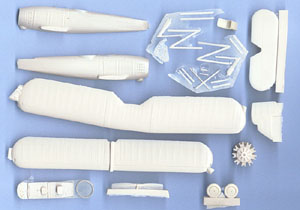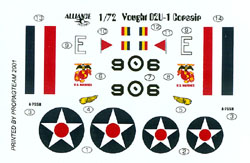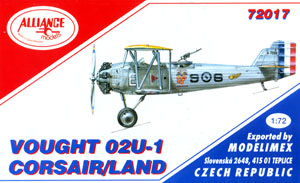Alliance Model's 1/72 Vought O2U-1 Corsair (Land) | | History Designed in 1926 to a Navy requirement for rugged observation type which could double as a dive bomber, fighter, or trainer, the O2U-1 Corsair lived up to - and beyond - all expectations. It was faster than any two-seater then in service. The O2U-1 was the first US aircraft designed specially for the new 450hp Pratt & Whitney R-1340B Wasp nine-cylinder air-cooled radial engine. The Corsair was tested at Anacostia Naval Air Station, beginning March 18, 1926. The first Corsairs went to sea in late 1927 replacing all previous scouting and observation types aboard US battleships, cruisers and aircraft carriers. Convertible to either fixed gear or floatplane, the two-seater Corsair featured a finesse of line and balance of proportion and form. As the first production carrier aircraft it had the distinction of serving aboard the first three US aircraft carriers: the USS Langley, the USS Saratoga, and the USS Lexington. Extensively used by 1928, most O2U-1s were replaced by O3U or relegated to reserve status by 1933. A total of 769 Corsairs were built of which 185 were exported. The Japanese Imperial Navy developed the Nakajima Type 90 (E4a-1) based on the O2U-1 and blueprints purchased from Vought in 1929. (Quoted verbatim from the instructions.)  The Kit The Kit
There's little difference between this kit and the float version (reviewed here in the July 2001 issue) with the obvious difference being the wheels instead of the floats. The kit consists completely of resin parts, and while the surface detailing is crisp and nicely done, there's at least one potential problem with the kit. More on that later. The interior of this kit is fairly basic, but I might be biased as the last O2U model I saw was the scratchbuilt 1/16 example by George Lee & John Alcorn. Compared to that, ANY kit would look fairly basic! The interior is made up of a one-piece cockpit floor with a separate control stick, seat and instrument panel. There's some detail molded onto the sidewalls as well, but that's it for the insides. Plenty of room for improvement should you wish to add detail, but just out of the box it should look great due to the small cockpit openings. The fuselage is where the main problem lies with this kit. The two halves are of different sizes, with the left side being smaller than the right. Spreading the left side a bit and pinching the right side a bit can probably fix this, but this will result in an oval-shaped fuselage. It shouldn't be too noticeable, as the difference isn't that great. Besides which, to fix it would involve scratchbuilding an entire new left fuselage half, in which case you'd probably want to just do the whole fuselage and fix the mismatched panel lines, different sized rear gun ring mount, and uneven stringer detail. Aside from the mismatched panel lines, these problems won't be very noticeable under a coat of primer, so it all depends on how far you want to go with this kit.  The rest of the kit is pretty basic, with the upper wing being one piece and the lower wing split into right and left halves. The stabilizer is also one piece, and the vertical fin and rudder is also molded as one. Also molded as one piece are the engine and propeller, all of which are very nicely cast. The struts are probably best replaced with more sturdy material (either brass or plastic), but look nice anyway. The rest of the kit is pretty basic, with the upper wing being one piece and the lower wing split into right and left halves. The stabilizer is also one piece, and the vertical fin and rudder is also molded as one. Also molded as one piece are the engine and propeller, all of which are very nicely cast. The struts are probably best replaced with more sturdy material (either brass or plastic), but look nice anyway.
The decals are the final step in this kit, and these really shine. Printed by Propagteam, they are in excellent register and the colors are perfect. You get only one choice, but the sheet is very complete with roundels, rudder colors, fuselage markings and unit insignia. The plane is from VO-9M of the US Marines and is overall silver with a yellow upper wing and upper tailplane as seen on the boxtop. Conclusion If it weren’t for the fuselage problems this would be an outstanding kit. Even with the problems there this is likely to be the only 1/72 Vought O2U available. With a bit of work it shouldn't be too hard to build a nice replica of this aircraft from this kit. | 

 




|
